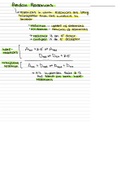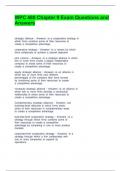Numerical Methods for Civil Engineers II
Assignment 1 Answers
Semester 1 2024
0027 65 934 4052
,
,
,
, 1.1 Partial Differential Equations (PDE’s) are mathematical equations that involve
partial derivatives of an uknown function of several independent variables. These
equations describe how the function and its derivatives vary with respect to these
variables. PDEs are widely used in physics, engineering, and other scientific
disciplines to model a variety of phenomena such as heat conduction, fluid
dynamics, electromagnetic fields, and structural mechanics.
For civil engineers, PDE’s are of paramount importance as they provide the
mathematical framework to describe various physical processes relevant to civil
engineering applications. For instance, PDE’S are used to model the behaviour
of materials under stress, the flow of water in rivers or porous media, the
distribution of heat in buildings and the dynamics of structures subjected to
external forces. By solving PDE’s, civil engineers can predict and analyze the
behaviour of structures and systems, optimize designs and ensure the safety and
efficiency of infrastructure projects.
1.2 I agree with the statement made by the APM4814 student regarding the use of
discretization to solve PDEs. Discretization involves approximatiing the continuous
domain of a PDE with discrete set of points or elements, which allows for the
application of numerical methods to find approximate solutions. While the result
obtained through discretization is indeed an approximation of the analytical
solution, it is possible to refine this approximation by increasing the resolution of
the discretization or by using more sophisticated numerial methods. As the student
mentioned , it is indeed possible to reduce the error associated with the numerical
solution to a point where it is satisfactory for practical purposes. This can be
achieved by employing techniques such as adaptive mesh refinements, higher
order discretization schemes and iterative solvers. While the numerical solution
may not be an exact representation of the analytical solution, it can provide
valuable insights into the behaviour of the system being modeled and can be used
to make informed engineering decisions.
Assignment 1 Answers
Semester 1 2024
0027 65 934 4052
,
,
,
, 1.1 Partial Differential Equations (PDE’s) are mathematical equations that involve
partial derivatives of an uknown function of several independent variables. These
equations describe how the function and its derivatives vary with respect to these
variables. PDEs are widely used in physics, engineering, and other scientific
disciplines to model a variety of phenomena such as heat conduction, fluid
dynamics, electromagnetic fields, and structural mechanics.
For civil engineers, PDE’s are of paramount importance as they provide the
mathematical framework to describe various physical processes relevant to civil
engineering applications. For instance, PDE’S are used to model the behaviour
of materials under stress, the flow of water in rivers or porous media, the
distribution of heat in buildings and the dynamics of structures subjected to
external forces. By solving PDE’s, civil engineers can predict and analyze the
behaviour of structures and systems, optimize designs and ensure the safety and
efficiency of infrastructure projects.
1.2 I agree with the statement made by the APM4814 student regarding the use of
discretization to solve PDEs. Discretization involves approximatiing the continuous
domain of a PDE with discrete set of points or elements, which allows for the
application of numerical methods to find approximate solutions. While the result
obtained through discretization is indeed an approximation of the analytical
solution, it is possible to refine this approximation by increasing the resolution of
the discretization or by using more sophisticated numerial methods. As the student
mentioned , it is indeed possible to reduce the error associated with the numerical
solution to a point where it is satisfactory for practical purposes. This can be
achieved by employing techniques such as adaptive mesh refinements, higher
order discretization schemes and iterative solvers. While the numerical solution
may not be an exact representation of the analytical solution, it can provide
valuable insights into the behaviour of the system being modeled and can be used
to make informed engineering decisions.





